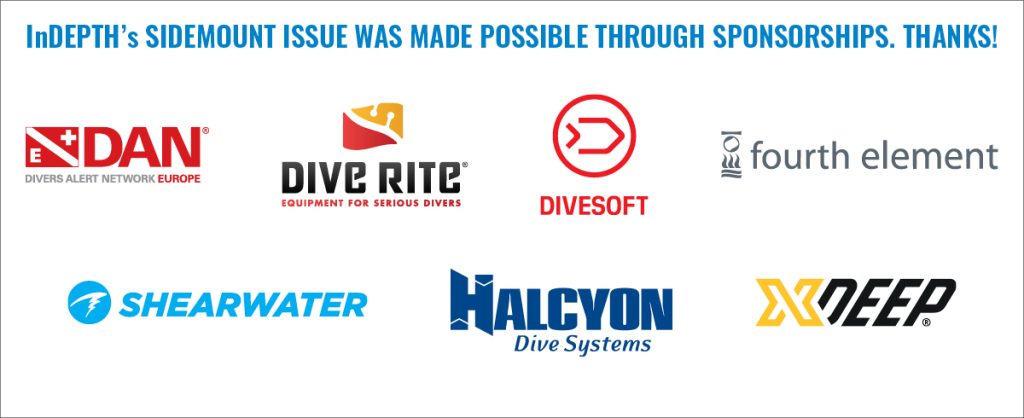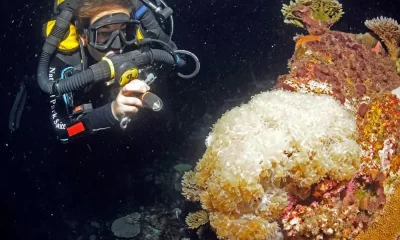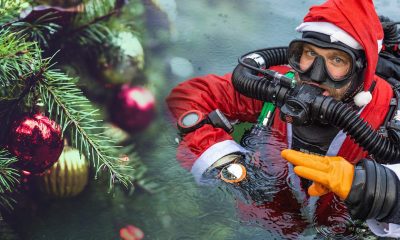Community
Speaking Sidemount with Educator, Influencer and Producer Steve Davis
Sidemount divers represent a large, vibrant, evolving community, call it a subtribe, within the cave, tech, and rec diving communities. Here InDEPTH chief Michael Menduno, sits down with veteran sidemount instructor, and the producer and host of the “Speaking Sidemount ” podcast, Steve Davis to explore the world of sidemount. Buckle your harness.
Interview by Michael Menduno. Images courtesy of Steve Davis unless noted.
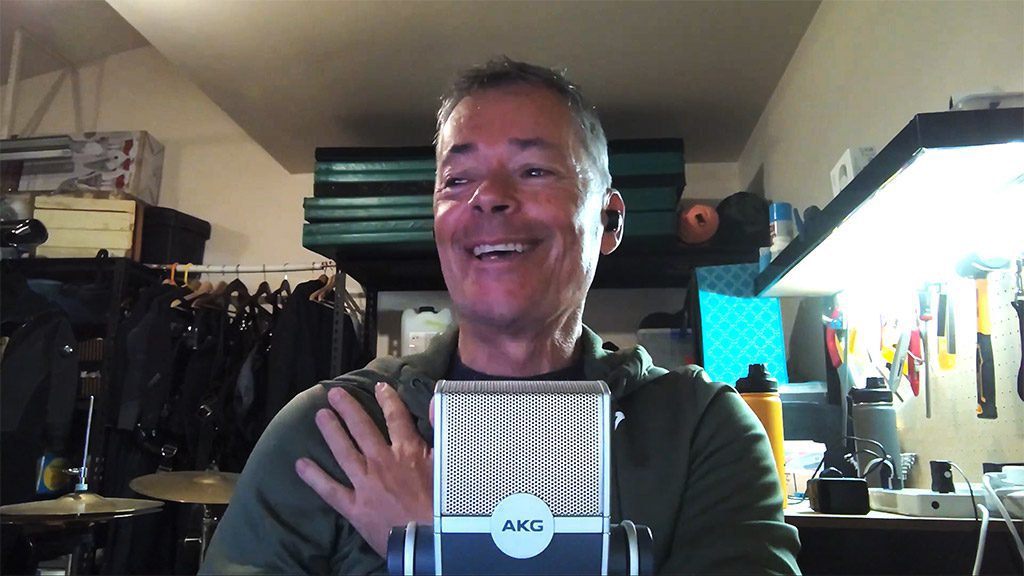
InDEPTH: Steve, how and when did you find your way into sidemount diving?
Steve Davis: An interesting question. It was 10 years ago around the time, for me personally, that I was starting to explore how I could get more from diving. I was a divemaster at the time and I’d been diving for a long time but, honestly, because of my age, I started diving in 1976.
Same year as me.
Yeah, I got pushed underwater as a 14-year-old by my Navy diver stepfather. But I did my first course in 1981. I was very much a crayfish hunter, lobster hunter. In New Zealand it’s massive. If you go for a dive here people ask you, what did you catch? So everyone is out hunting and bringing food home. And so that was me for 25 years.
And then I sort of got sick of looking under rocks so I thought, how can I just dive and be better? And back in those days, you will know yourself from starting your magazines in the 90s, there was very little… I didn’t even know technical diving existed. And so I’m in my own little bubble diving away thinking, how can I be better. And, to be honest, it was a long time after you did your work and formed the technical diving revolution, as we refer to it now.
Viva la revolución!
Ha! It was around 2009/2010 that I was starting to think, I really want to find a way to dive better and more, and I came across a YouTube video of Steve Bogaerts sidemount diving at Ponderosa. I’ve now interviewed him twice and we keep referring back to that. I just watched this guy in the water. And it was like poetry, it was like ballet, watching this man completing skills neutral in trim, complete skills, very little fin movement, very little hand movement and swim around and just look as if he belonged in the water. As Bruce Lee would say, “he was one with the water.” And I kind of just thought, that is me. I’ve got to find out what that guy was doing.
So I was researching and researching and then I found Steve Martin who at that time was also teaching sidemount. In fact, between the two of them, they were doing the majority of what was available online on sidemount. And so the more I looked at it, the more I listened, especially to Steve Martin’s promo about it. I thought, yeah, this is something that I really want to explore. So I reached out to him—he was running a course in Mexico and he was collaborating with cave explorer instructor Jason Renoux. And so I went over to Mexico and did a course.
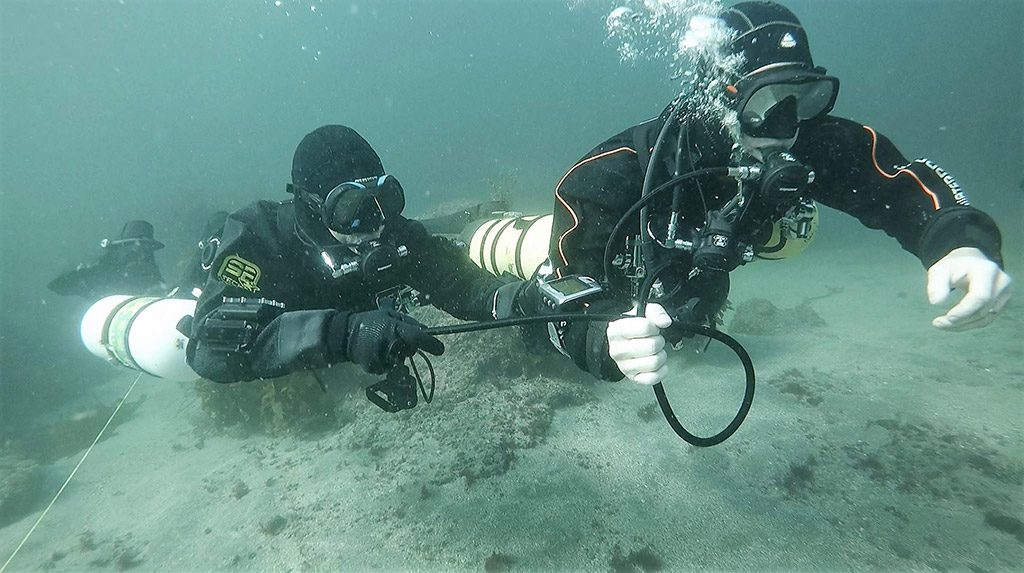
Your first sidemount course?
It was a sidemount course first, followed by cavern and intro to cave training immediately after that. I wouldn’t necessarily recommend doing that, but that’s how I got into it. And I mean from the moment I got in the water in Ponderosa in sidemount and fell into trim, started doing a pretty rudimentary frog kick with Jason, who also had done GUE fundies as well as being a great sidemount diver and instructor. Yeah, Steve wasn’t there, unfortunately, but Jason just gave me such a good experience. I was extremely comfortable in the water, so it wasn’t challenging from that point of view, but what I learned on that course set me on the path to where I am now. And it was just so cool.
But you took it a step further and created a podcast about sidemount diving. Please tell me how and when did that come about?
It was in 2018, actually quite a long time after I started diving sidemount. When I finished working as a software executive in America, I decided to take a couple years and just explore diving. And I had the time, and the resources to be able to do that then.
So I went… I was going to train with Steve Martin. That didn’t work out. However, Tom Steiner who runs GOZO TECHNICAL DIVING in Malta, a tremendous guy, collaborated quite a lot with Steve Martin. I had seen videos of Tom and his then partner Audrey Cudel, sidemount diving and I thought, wow, these guys are the same level as Bogarts and Steve Martin. A different type of diving and they are not explorers, but it was compelling.
I went to Gozo Technical and did a few months of training with Tom and was invited back to teach for him the following year. And so having done instructor training and open circuit trimix and cave with him. And so I worked there for a season and I thought—this was going to be me. I was going to open a dive center and teach sidemount diving. And so I looked at the possibility of buying a dive center and or opening one here in New Zealand. But I just couldn’t get my head around how to make the business work where I live in New Zealand.
So I ended up opening a coffee shop, which has become extraordinarily successful. So that was brilliant. But I thought, damn, I’m not diving as much as I want to, I’m not involved as much as I want to. At the time, I was looking around at all the sidemount Facebook pages and forums and I became quite disillusioned with what was going on.
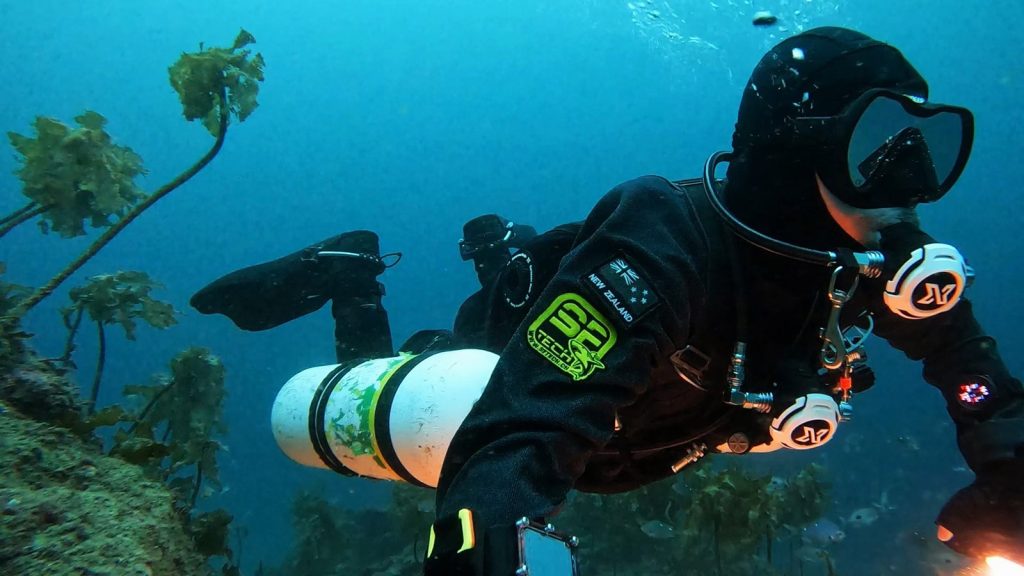
Why was that?
There was a lot of pretty nasty social media comments and divers would post pictures and immediately be shot down by all the keyboard divers. So it was not a very positive environment. But I knew through the Facebook pages and forums that there was a rabid audience for sidemount information. But there was a lack of quality and a lack of depth. No one was hearing from the upper echelon of sidemount diving, the Bogaerts and Martins and Steiners. They weren’t the ones commenting.
So I thought, there’s got to be a way to get their voice out. And I was listening to, of course, Joe Rogan at the time a little bit and so podcasting was becoming big, starting to grow at the time. I thought I could start a podcast. And I had no idea how to do it, what to do, so what do you do? You go to YouTube and you find out. So I basically found a couple of YouTube channels that showed me how to do it. And if you listen to the first episode there is a kind of very nervous Steve there.
Ha! You should have seen our first InDEPTH!
I think the first episode is about 20 minutes long. And then it kind of grew from there.I felt there was a need to get the voices of the top sidemount divers in the world out there, and to be able to ask them questions and get their answers to the sorts of things that people wanted to hear.
It really became successful when I was able to start getting the luminaries on. I got Tomasz Michura on episode 2, Garry Dallas on three, Steve Bogaerts on eps four and five followed by Brian Kakuk and Jill Heinerth and we just went on from there. Extraordinary divers and absolutely amazing people as well. I was happily shocked that they were willing to talk with me on air.
I’ve had the good fortune to meet many of them since then. That’s really how it started. And it’s definitely been a labor of love. It’s not particularly financially lucrative. That’s not the reason behind it. I’m very fortunate that XDEEP jumped on really early and sponsored it, which was amazing because I don’t think I could keep doing it without that support. So that’s how that kicked off.
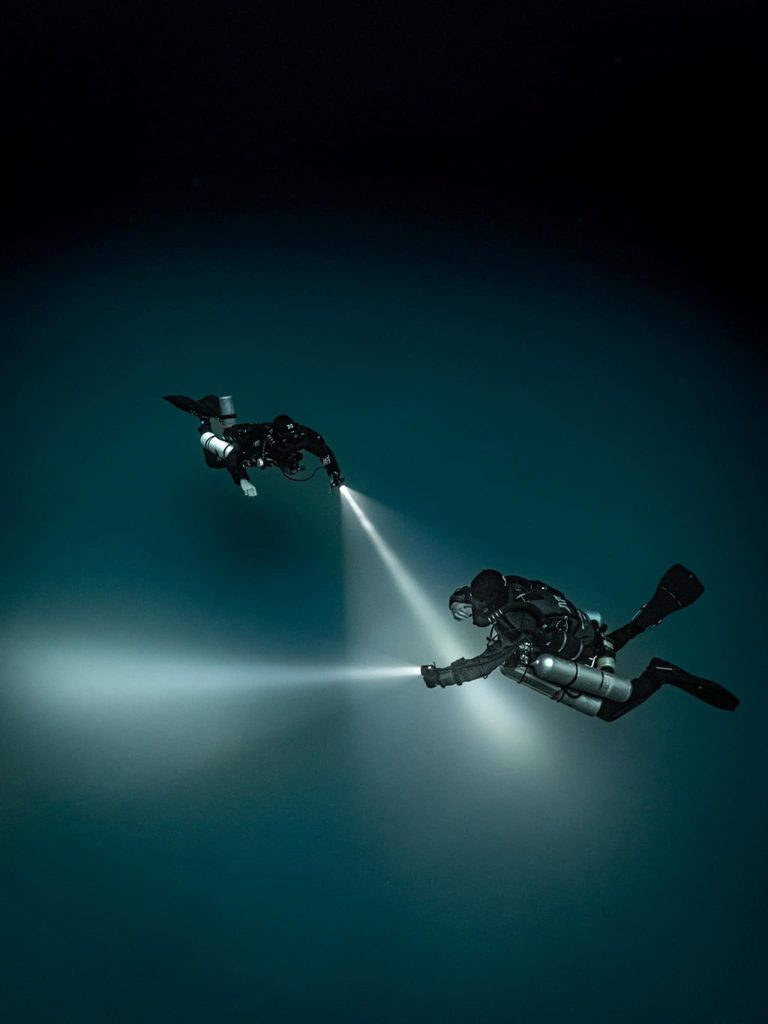
Diving not financially lucrative?!? I guess that explains it! And how many episodes are you up to now?
I just finished editing episode 86 with you as our guest. In the beginning I was doing an episode a week. You know how excited you get when things start out. But it was unsustainable in terms of finding guests and the amount of editing that is required. I now do an episode a month.
I’m excited to be on the podcast! So I am going to ask you questions for divers like me who haven’t dived sidemount and aren’t familiar with that world. Let’s start with, why does sidemount require such personalization and customization versus back mount diving?
Yeah, great question. So the sidemount provides a massive amount of flexibility in the way that you execute a dive. But the counter of that is that there’s also quite a lot of complexity in terms of the way that you set your system up. And the reason for that is that the cylinders are completely independent. And so it’s a strength and a weakness in a sense.
So because each cylinder is independent, you have to independently set up each cylinder. Now they set up exactly the same but opposite each other. But there is a little bit of getting that on your body. So when we run a course, the beginning of the course is three workshops. You have a harness workshop where we fit the harness to the diver. And the fit of the harness is really important, it’s a little bit like fitting a suit. You need to make sure that it sits in the right position on your back, that the waist strap is the right height because that then influences where the connection of the cylinder is on your hips. You need to make sure the shoulder straps are correct, that the D rings are in the right place. And so that the loop bungees, if you’re doing Mexico style, are the right length as well. So there’s a bit of set up for that. None of this is particularly long, it’s probably a 30 minute, 45 minute exercise.
Then you go to the cylinders and you mate the cylinders to the harness and to the diver’s body. So everything is completely configured and individualized to the height of the diver, the girth of the diver. So all of these things make a difference. And the last thing you set up is the regulators which is the easiest except for getting the hose lengths correct. And generally most people fit out of the box. You’ve got, again, depending on the style you’re diving, if it’s Mexico again you’ve got a 7 foot or 210 cm long hose and a short hose on a necklace which maps to the Doing It Right (DIR) Hogarthian configuration with the exception that we switch regulators.
So that’s really the answer to that question. You get paid back later for the complexity because you get so much flexibility and being able to don one cylinder at a time, don in the water, don on the boat, don on the land. So there’s just all of this flexibility that flows from that.
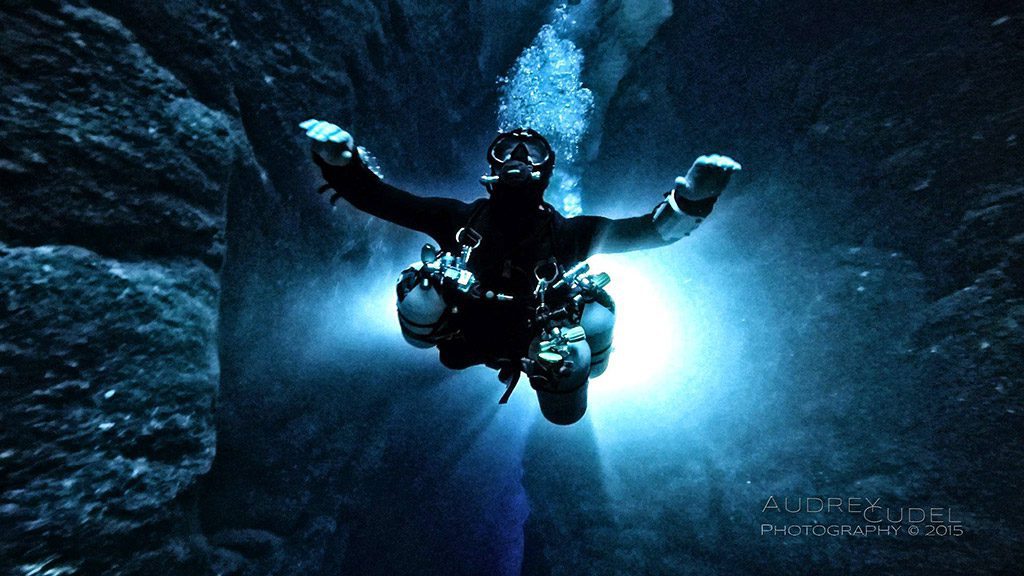
I’m a Global Underwater Explorers (GUE) member. We have a standard backmount configuration. Of course, I would argue, for the most part, the tech community has pretty standardized the backmount configuration. I mean there are small variations; which arm you wear your computer on, whether your hoses cross or not, but for the most part backmount is settled. And there’s arguably a certain safety aspect to that because everyone’s on the same page. But what happens when you go to sidemount? Does all standardization go out the window? Does that create safety issues?
Well, it doesn’t go out the window, but there is a certain amount of individuality that… I won’t even say allowed because there is no authority over sidemount diving, of course. But there is an amount of individuality that’s required. But the basics remain the same. The two independent cylinders remain the same. Unified Team Diving (UTD) have tried to connect them together with a switch block, but I think the vast majority of sidemount divers have two independent cylinders. So that’s kind of the beginning.
Regulator switching is also relatively common. Most common is to have a long hose on the right, a short hose on a necklace on the left. Not everyone does that though. So, for instance, the Innerspace Explorers (ISE) people have two one meter hoses. But I think the safety aspect is a little bit overplayed because what tends to happen is, for instance, if I’m diving with a backmount diver and I’m in sidemount, they look at me and they pretty much will recognize what I’ve got. They’ll see a long hose, they’ll see a short hose, they know that if I’m going to donate gas to them, I’m going to donate the long hose. The only difference is, that it might not be in my mouth when I donate it. And so it may be coming off the breakaway clip on my D-ring. Which people make a problem. It’s not a problem. You break it away and then donate as if it’s in your mouth.
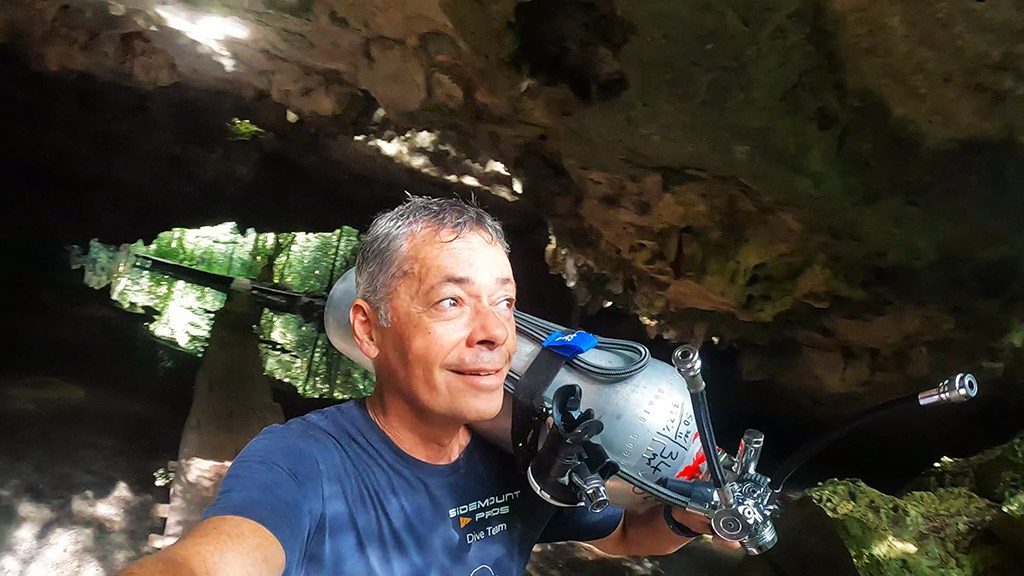
Right. Open circuit sidemount divers switch back and forth between regulators throughout the dive. So you may not be breathing the long hose, but you were five minutes ago and then re-stowed it, right?
Totally. It’s a massive thing, one of the foundations of the DIR concept is to donate what you breathe. And the reason is, because you know it’s working. Then the problem is, well, do you know that the hose on your necklace is working? Perhaps the last time you breathed it was on the surface. And imagine the scenario where you donate and then you change to your necklace and it doesn’t work and all of a sudden you’re in a fistfight over who gets the long hose, right?
That’s the scenario DIR wants to avoid!
So the advantage in my mind of sidemount in that sense is, yeah, it might not be in my mouth and there is a potential issue that we have solved with breakaway bolt snaps. So we can break it away and donate it. But I know that the other regulator is working because I breathed it literally a few minutes ago. And again, back to the safety thing. Donate what you breathe because it’s safer. Well, that safety issue doesn’t really exist.
And I had a bit of a discussion about this with Patrick Widmann yesterday. Some people are saying you’re going to die if you do this, but I think this is overplayed. So long as you’ve got a system that has been thought through and you’ve practiced safety drills and it’s easy for your buddy to see or for you to communicate to them how your system works, there shouldn’t be any big safety issue. If I’m diving sidemount and you’re diving back mount and I’m diving a one meter hose, so long as I can get a hose to you if you need gas or provide it, I can manage my equipment safely in an emergency situation. There shouldn’t be an issue then.
Ah, if you’re diving in mixed teams, having a sidemount long hose makes good sense-to be able to assist the backmount diver. But if it’s a team of sidemount divers, then a long hose really isn’t needed because everyone has got redundancy.
That’s right. You don’t need a long hose if you are solo diving, exploring for example, or part of a team and solo diving—think Cave Diving Group (CDG) protocols, or diving in a sidemount team. [Ed. note: GUE does not sanction solo diving.] If you are in a mixed team, then the long hose makes a lot of sense. Here the backmount twinset divers will also have a long hose so they will be familiar with both your setup and processes in an out of gas (OOG) situation.
Note that in sidemount, it is extraordinarily unlikely you will have an emergency—a “time sensitive” OOG. More likely you have one cylinder go out, you switch to the other, maybe go back to the other damaged cylinder if you can “feather the valve” to breathe the gas, or “wet breathe” it etc. and
Then later, hopefully in a controlled fashion, you can share some gas with a teammate on deco or during overhead exit if needed.
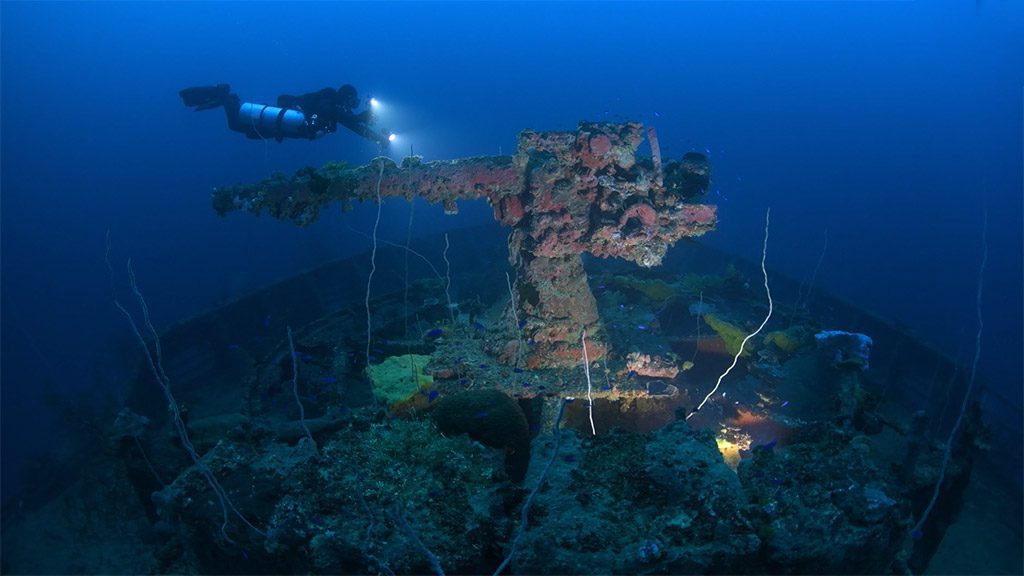
When you donate gas in sidemount, do you actually hand them the cylinder then exit? Or do you keep the cylinder, and exit together?
It depends. It depends if you’re diving steels or aluminum and whether you are carrying a long hose. Typically with a long hose, you donate the hose and keep the cylinder just like in a backmount twinset. However, the ISE people are diving one meter hoses and aluminum cylinders. Their protocol is to donate a one meter hose, get themselves steady, stable and happy and then hand the out of gas diver the cylinder. You can do that with aluminum cylinders. You can’t do it with steel.
Because of balance and weights?
Exactly. But just like GUE, if let’s say we were breathing a nitrox 50 and we needed to donate a 50, not some sort of hypoxic trimix for instance. Then we would or could give them the 50 and say, here, you have the 50 for a while. Get yourself steady and maybe we are going to share it or maybe someone else on the team is going to support us in terms of the decompression that’s required.
So yes, we donate a cylinder because it’s aluminum. But if you’re diving steels on a long hose, no. If you have aluminum cylinders and a long hose, probably not, because that’s why you have a long hose. Aluminums with one meter hoses, totally. Bogaerts does exploration with two short hoses. Sorry pal, we are not in a gas sharing configuration now. We are explorers. You’ve got your gas, I got my gas. And there really is an important point there too to note about sidemount. Because the cylinders are completely independent, what is the scenario that I could possibly have an out of gas situation? A complete loss of gas?
Right, you’d have to have two independent failures, and the odds of that are tiny. If the odds of a failure of one cylinder set-up are 1/1000, then the odds of two independent cylinder set-ups failing is 1/1000 x 1/1000=1/1,000,000. It’s very unlikely, even if the odds were 1/100.
Exactly. What’s much more likely is that I’ll have one failure, in which case the solution is basically switch regulators, shut that cylinder down and then we’ll alert our team, swim out of the cave or start our ascent. And then at some point during that ascent it’s possible that I may need to share gas. And we can do it in a very controlled way at the right time.
The other cylinder is either gone or I could feather the valve, but it’s probably more likely, especially under a stress situation I will say, hey, can you give me some gas? So it’s not an immediate, oh my God, I’m going to drown if you don’t give this to me in 10 or 20 seconds. So there’s quite a big advantage. The most likely scenario for a sidemount diver is to have to donate gas to a diver in a different configuration, for example, a single cylinder or twin set or potentially a rebreather diver who doesn’t have the same degree of redundancy.

I was down in Mexico late last year. I hadn’t been for a while, I showed up at Ponderosa and instead of seeing 90% backmounts and 10% sidemount divers, it was all sidemount divers with a few backmounters. Any sense of what percentage of the cave divers are sidemount divers?
I have a sense that it’s high and it’s growing. And the reason that is, I believe, is the old adage: pick the right tool for the job. I know there’s a lot of criticism of sidemount on boat diving and the criticism is that it’s not the right tool for this job. And I disagree with that to a point. There is a point, depending on conditions, where it becomes very difficult. Generally, you can dive sidemount on boats, just as you can dive backmount.
Now if I switch that around to cave diving, can you dive caves in backmount? 100%. Can you dive caves in a big bulky backmount rebreather? Of course you can.
You’re not making fun of the GUE-configured JJ-CCR now are you? Ha!
No, of course not. Well maybe a little. My point regarding backmount is this—is it the best tool for cave diving? No, it’s not. Sidemount is far and away the best tool for cave diving.
But I want to make the point too that, just like any type of configuration, you can’t just pay it lip service. If you want to become a really capable, competent sidemount diver, you need to be knocking out sidemount dives.
My point regarding backmount is this—is it the best tool for cave diving? No, it’s not. Sidemount is far and away the best tool for cave diving.
Unless you’re diving every day, switching configurations, for example, diving backmount today and sidemount on Thursday, backmount on Friday and sidemount on Sunday, would work just fine, if you’re doing a lot of diving. But most of us only get to dive a few times a month. So the idea is, if sidemount is the best tool for cave diving, it might be the best one to use.
I think that’s why, sooner or later, you’re gonna find a cave that either has real restrictions, or an area, which has really delicate formations that you do not want to knock around. So there’s just no question that sidemount is the best tool for cave diving.
You saying that surprised me. If you would’ve said sidemount is the best tool for tiny, restrictive caves I would’ve said “Of course, that’s why it was invented. But now you’ve broadened that out to cave diving in general.
Yeah.
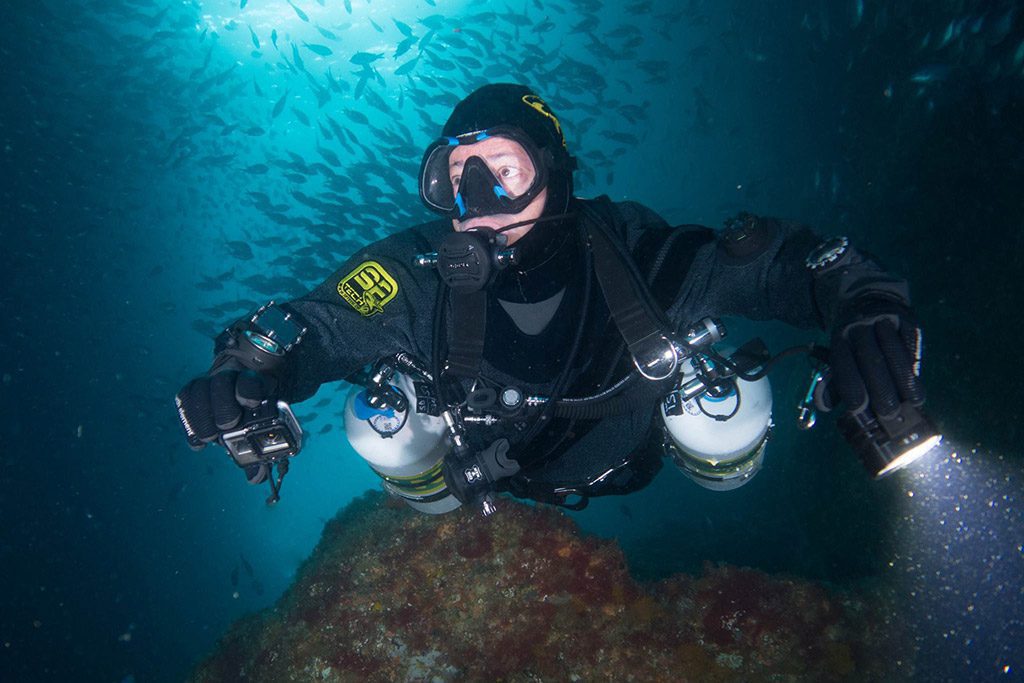
So explain why it’s better than back mount.
Well, let’s start at the car park. Let’s think of any of the caves in Mexico that you’ve dived recently. The vast majority of them have a nice car park and a set of steps that you walk down to get in the water. And so we turn up… Before I put my drysuit or wetsuit on, I just grab a cylinder, casually walk it down and place it beside the entry point. Come back, carry the other one down. Easy as, I don’t need to be particularly strong to do that, I don’t need to expend a lot of energy or anything. And then contrast that with carrying your twinset down a set of steps. And of course, we’ll be coming back up the steps at the end of our dive. So it’s just easier to get to the water.
Then we look at donning in the water, it’s just unbelievably easy. Again, contrast that with a boat, much more difficult. So just put them on. And then diving is diving. Once you’re in the water, sidemount, to me, is extremely comfortable. No negatives whatsoever in the water. And so if you’re in big cave, small cave, really, there’s no difference in terms of the ease of diving it. And the same with backmount. Backmount is super easy in big cave. But eventually, as I said, you come to something that’s small or you come to something that has formations that you do not want to damage. And so better to be in the right tool when that happens. And better to have practiced it as well.
Ah, and because you can see and manipulate your regs, first & second stage, and deal with failures directly and fix things yourself, or feather your valves if needed, as opposed to having to have a team check your leaking manifold. It’s another layer of safety. I hadn’t thought of that before. Lots of drill time in classes is spent fixing your team’s mate problems and sharing gas.
Exactly right.
It seems that there are at least seven different branded systems for sidemount diving; the CDG, Bogaerts Razor, Dive Rite, Halcyon, Hollis, Toddy Style, XDEEP, and I know there are more. How did that come about? And are they really different? How did the differences come about?
Well, it’s actually quite subtle. It obviously started with the CDG in the UK. It was a tool to achieve a job. They were doing a lot of dry caving, dragging equipment, and then needing to dive through occasional sumps. So they didn’t need a great deal of diving set up. It was more about how do I get my cylinders to the water and how do I get them through this dry cave?
And then when you come to the historical Florida cave divers, they were predominantly diving flooded caves, and so all of a sudden buoyancy control, trim and balance became more important. Because of flow they thought steel cylinders would be the best tool. Lamar Hires invented the Transpac and on it goes. So all of the equipment and everything was to deal with high flow caves and diving through restrictions using sidemount. So that’s how they developed their system.
Then if you look at the environment in Mexico, the caves don’t have flow and are highly decorated. And of course, in Mexico everyone has aluminum tanks not steel. And so Mexican cave divers started to come up with their own system of doing sidemount.
Andy Davis has a great piece in this issue on the evolution of the two— Florida vs. Mexico styles, “The Evolution of Sidemount System Design.” Other differences?
Yeah, there’s a variety of subtle differences like, which way do you face your regulator? In Florida you are going to find the regulator is facing forward quite often. In Mexico, the Bogaerts and those who were setting up there, Bil Phillips was amongst that group as well, thought, turn them the other way because we want our regulators facing toward our body and not exposed to the cave. That was from don’t damage the regulator and also don’t damage the cave, perspective. So yeah, these little subtle differences crept in. But there’s a lot of similarity as well; not so much of course with the CDG system, because that was designed for a different mission.

Different, yeah.
Independent diving but diving as teams. So they’re not donating gas a lot or doing those sorts of things. But both Florida and Mexico very much came with a long hose, short hose concept. And then there are subtle differences. I’ve got students who go to Australia, for instance, and their particular instructor doesn’t like to have the short hose on a necklace in case somebody tries to drag it from your mouth. Which is a fair point. So she wants them to clip off the short hoses while using the long hose. So you’ll find these subtle little differences that have been thought through for different reasons. I do think that long hose is ubiquitous, as is the short hose on a necklace. So those things are very common.
And then there are various methods of attaching cylinders, rails versus D-rings on the waist, little differences like that, but in the main, we are diving very similarly. And I think there is a recognized standard of what good sidemount diving entails. Being in trim, cylinders in trim with your body, not sticking up in the air, and tech diving posture the same as for backmount.
Would you say sidemount systems are still evolving? Or are they pretty stable at this point?
They’ve been stable for a few years now. I mean there’s been a few new systems. Hollis came out with their Katana 2 recently, and Dive Rite just launched their new Nomad Ray. These are reminiscent of the XDEEP and Razor. They all go back to Brett Hemphill’s Armadillo in terms of the overall concept. So there’s been a bit of evolution.
I know now with sidemount rebreather diving growing, developers are taking a more careful look at what can we do to evolve the harnesses so that they work better with the rebreathers? And again back to the Sidewinder 2, I’m sure at some point we are going to see further enhancements to some of the harnesses in particular to enable that.
I understand that the Katana 2 addresses the rebreather issue. Thanks to companies like Divesoft, XDEEP, Fathom and others, sidemount rebreathers, whether as a primary or a bailout, are gaining popularity.
Certainly if you ask what’s the revolution in sidemount diving right now, it’s sidemount rebreathers. And that’s been driven just the same as everyone else. The price of helium, oh my God, I mean I had two seven liter cylinders filled here. It cost me $450 and I’m rebreather diving. Mind you, the price is the same. I’ve still got 150 bars in each, thankfully after a weekend. But oh my God. So I think that’s driving rebreathers to a very large degree now.
And also the improvements that we are seeing in rebreathers is alo helping to drive demand.
So I think, if anything, open circuit sidemount is quite stable. I don’t see a lot of new evolution, or revolution there at the moment. But certainly there’s a lot going with sidemount rebreathers.
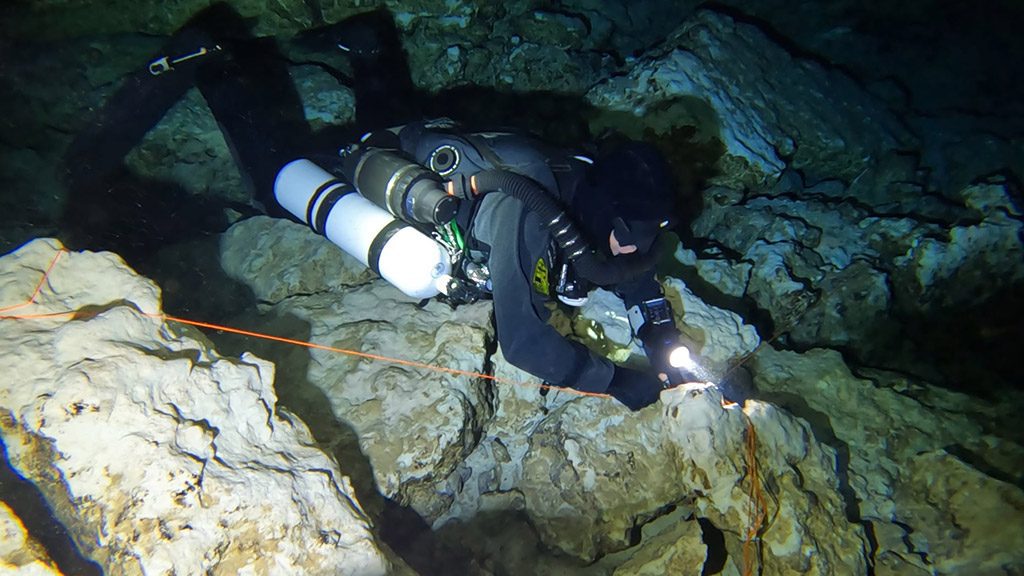
And there’s the whole software side of that too. For example, Divesoft, has created a system, if you are using a Liberty sidemount as a bailout for your backmount rebreather, the sidemount knows that its a bailout and is talking to the main unit. I understand Shearwater is developing bailout software as well.
Agreed. It’s exciting.
Let’s talk about limitations. I interviewed Edd Sorensen of course, wonderful Edd. He said, people always tell me what I can’t do in sidemount, but the fact is, I can do anything in sidemount that they can do in backmount. Nat Gibb said the same thing.
Conversely, Richard Harris, Dr. Harry explained to me that they use dual backmount rebreathers, because they are very deep (> 200 meters) and the work of breathing on sidemount rebreathers is generally not good for uber-deep diving. Then of course there is the issue of boat diving. So those are the two main limitations that I have heard; deep diving and boat diving. BUt you’re telling me they are not necessarily limiting.
So I don’t know if a lot of people know that, yes, I’m a cave diver and I love caves, but I predominantly dive from both fast RIBS and from charter boats. There’s no question on a fast RIB it is super easy to dive sidemount because sitting on the pontoons and putting your cylinders on and just elegantly falling into the water. Everybody’s handing their gear up at the end of the dive. No one’s climbing out of… Back mount, sidemount, doesn’t matter. You’re all handing your gear up. So it’s really a push. And by push I mean identical. I’m no slower. Sometimes because I’m practiced I’m faster, but it’s exactly the same.
Charter boats are a little bit harder, when you have to walk to an exit or entry point. But then there’s a lot of flexibility. One of our Who’s Who, Thomasz Michura did an amazing video series. He calls it his double ender series. It’s a series of him showing us how to boat dive, and demonstrating all the flexible options for getting in the water with no cylinders, with one cylinder, with two cylinders. And also donning in the water. The guy is an absolute technician of sidemount.
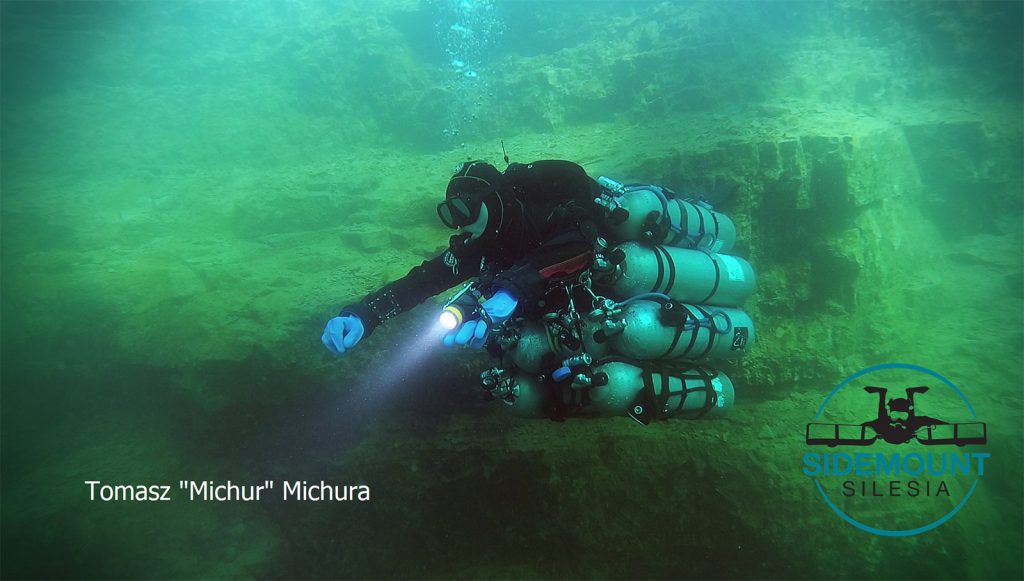
I have added a link to our interview.
It’s a really good example of highly evolved boat diving and sidemount. Having said that, when you look at his videos, and also most of my experience, has been in calm water. So let’s contrast that with diving in tough conditions. So, an example would be diving in the North Sea, for example diving Scapa or something like that with big seas. That can be challenging for backmount, let alone for sidemount. So you either decide that you make those sort of dives in a different configuration, or you don’t do them.
The truth is that for deeper technical diving where you’re carrying multiple cylinders, all of a sudden sidemount becomes a bit of a pain in the butt. Can it be done? Yes it can be done. Is it harder than backmount? Yes, it’s harder than backmount. So that’s where you start to hit the limitations of sidemount diving. And I’ve done tons of three cylinder, and some four-cylinder diving from boats—probably 30, 40, 50 dives. But again, a lot of that is in Chuuk Lagoon where it’s super easy to get in and out, people will pass you cylinders, there’s no current.
Backmount divers typically carry multiple cylinders for deep dives.
Yeah, very few of them get in the water by themselves. There’s almost always somebody assisting them to don the four stage cylinders. So, we all need a bit of help. You normally wouldn’t see me out of the water with three cylinders on in sidemount. And I don’t believe I’ve even seen anyone do that. However, I have donned three cylinders on the boat before when there’s been high current. And in fact I’ve done it with four. But I needed support from the boat, for sure and it was not easy. Once I’m in the water it’s fine.
But if there is a big current running, how are you going to hold onto a line and be donning cylinders in the water? You just don’t want to do that. So I think that’s where the limitations are.
How do you handle stage and deco bottles in sidemount?
People come to sidemount with a lot of different backgrounds. In particular, many have dived twinsets before they come to sidemount. So they’re quite used to managing their stage and deco bottles on their left side, which is the typical way of doing that. And as I said, some of them have come from GUE and been through Fundies. [GUE’s Fundamentals course] So they’re quite familiar with managing cylinders on the left side and the reasoning behind that.
Now in sidemount, one of the underlying foundational principles is balance of your system. So having a lot of weight on your left side is a little contrary to the underlying foundational principle of balance. So what we tend to do is to position your first deco cylinder or stage cylinder on your left side. So for deco, that might be a nitrox 50, for instance, that you would clip on your left. Now, if you’re gonna carry an oxygen cylinder as well, then you would put that on your right side and you’d route the hose. The left hose would come straight up and around your neck, and then the right hose might be the opposite of that and have an opposite entry, that’s one way of doing it. Or it might swing around in a similar way to the way your long hose does, and then it can be managed in that manner.
The beauty of doing it that way is several fold. The first one is you’re completely balanced in that you’ve got gas weight evenly on both sides of your body. The second major benefit is that it does make the management of hoses and making sure that you’re breathing the right gas a little simpler as well, because the regulators actually even look different. If you manage your O2 around your neck coming in from a left entry, it would actually be a different regulator configuration to the other side, so it would be very obvious which one you’re breathing. In either sense, that is a benefit in my opinion as well. Typically that’s the way you do it. And if you needed to mount travel gas as well, that one would go kind of in between the two, kind of resting along your stomach almost. You’ll be able to find pictures of people like Steve Martin’s done a few. Thomasz has done quite a few of these as well. In fact I think there’s pictures of him with up to 10 cylinders mounted on him, not for anything to do with diving, just more as a demonstration of him being uber balanced in a very, very equipment heavy mode. So yeah that’s the typical way.

Got it!
Having said that, I just finished my trimix rebreather training with Patrick Widmann and he preferred that we leashed the O2 cylinder and just had a 50 on our left side. And then we carried the O2 cylinder on a leash for the dive. And for that, I think it just depends on the dives you’re doing.
I use leashes quite often. I think they’re incredibly handy, especially when you’ve got a depleted cylinder that’s quite buoyant. So removing that from your system and putting it behind you means that you come back to that balance, which we crave. But I have heard people like Andy Davis criticize leashes in sidemount, because again, you’re not necessarily streamlined. And again, that’s another principle: being streamlined. So it depends where you are. I think if you’re open water, who cares? Leashes I think are fantastic. If you’re in an overhead environment, then you don’t really want to trail a cylinder. So, does that answer that question?
Two more questions. Training agencies. Does everyone now offer a sidemount course?
They do. But the thing that I don’t like about it is that, for instance, I’ll name agencies and you can decide whether to use it or not. But many of the recreational agencies, PADI in particular, have sidemount as a specialty. And so what that means is in order to become a sidemount instructor, you go and do instructor training and then you start piling specialties on top of that. So you start saying I want to be a dry suit instructor, or a nitrox instructor and there is very little training required for any of those in terms of instructor training. Now you want to be a sidemount instructor. So they take you for some sidemount dives and show you the set up and everything. But depending on where you are and what you’re doing, many, many instructors are certified as sidemount instructors with a day or two’s training, no more.
That doesn’t seem like much. I know with regard to PADI, they require a prospective recreational sidemount instructor to have taken a sidemount course and have 20 sidemount dives, or proof of 50 dives presumably for DIY sidemount divers, in addition to a 2-3 day specialty instructor course.
I liken teaching sidemount diving to teaching Intro to Tech at TDI. I don’t know if you know that course. Which is the introduction to backmount diving, and probably a little bit like GUE fundies as well. It’s kind of the first step that you take in two-cylinder diving in preparation for overhead environments and decompression diving.
Now GUE has taken it to an extreme I think. They don’t offer sidemount diving until after Cave 2. So the students are super experienced, very competent, and capable divers, and they will pick it up extremely quickly. So that’s one big benefit. Conversely, you could be taught by an instructor who trained in the topics and is teaching you sidemount diving, with little actual experience. As a result of that, we see a lot of very poor sidemount diving around the world. I think it’s improving.
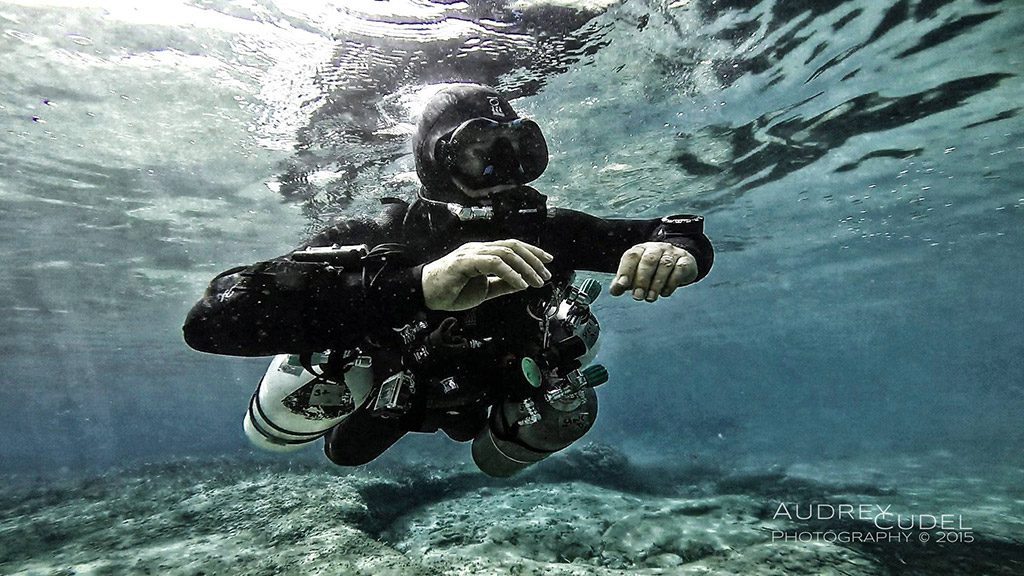
On the recreational side?
Yeah, exactly. In contrast, go to a cave diving region like Mexico, and watch other sidemount divers, and you’d go, “Oh my God, everybody’s good!” Know what I mean? Because they’re all sidemount cave divers and so that’s I think a big difference. Agencies are somewhat irrelevant in that sense.
We of course have a Who’s Who interview in the issue with Jeff Loflin, who was largely responsible for PADI’s recreational, and technical sidemount programs along with Karl Shreeves.
My feeling, having kind of done a bunch of interviews on this with leaders of various agencies is that to be a sidemount instructor you should have done, number one, a good course yourself. Then X number of dives. Then you go back and do instructor training and learn how to teach this very specialized set of skills. As we talked before, it’s much more complex than some of the others.
If you looked at me teaching, it would look a bit like a GUE Fundies course. So we’re out of the water practicing propulsion technique laying on a bench. We are land drilling all of our skills. We are expecting a high degree of buoyancy control whilst completing skills. And trim. And as you well know, GUE Fundies is no joke. It’s a serious level course whether you get a recreational pass or a tech pass. So that’s kind of where I think sidemount should be.
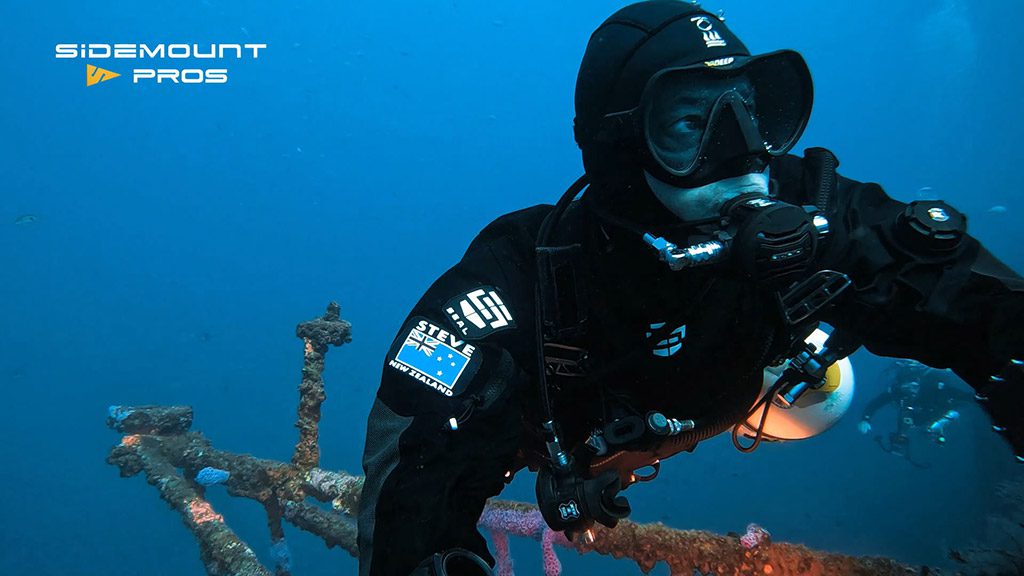
It almost feels to me that the sidemount community has its own subculture, they’re a sub-tribe of tech diving, if you will. Does it seem that way to you?
Yeah, 100%. In fact, I knew there was this rabid audience for sidemount that craved information. So yes, there is a subculture. And we’re getting better and better too. I think there’s less of the nastiness now and a lot more comradery and collaboration. And I hope I’ve been part of that, things have gotten just so much better.
These days it’s not uncommon to meet fellow sidemount divers. So it’s nice to be able to share ideas, help each other out. And when I travel, sometimes I’m traveling to places that I’m the only sidemount diver they’ve ever seen that’s quite interesting. But other times I’m going to cave diving regions where everyone else is doing it too, and the question becomes, are they doing it the same or different?
However, at the end of the day I think diving is diving. Sidemount is just another configuration. Yes, we have a big audience who loves it for very good reasons because it has some great advantages, but in the end, it’s just diving.
Thank you Steve! That’s a great message. You’re an excellent ambassador for our sport!
DIVE DEEPER
InDEPTH: All Episodes of Speaking Sidemount
InDEPTH: Who’s Who Steve Davis
